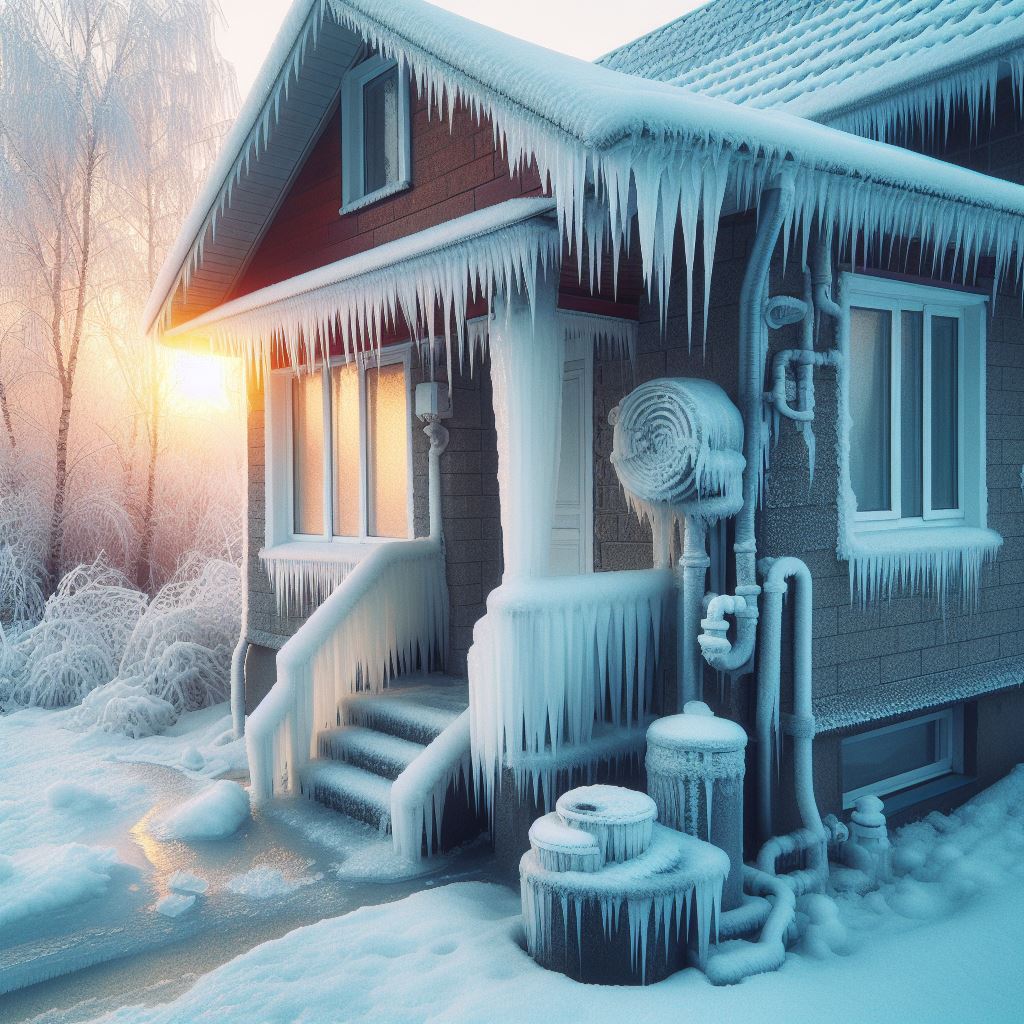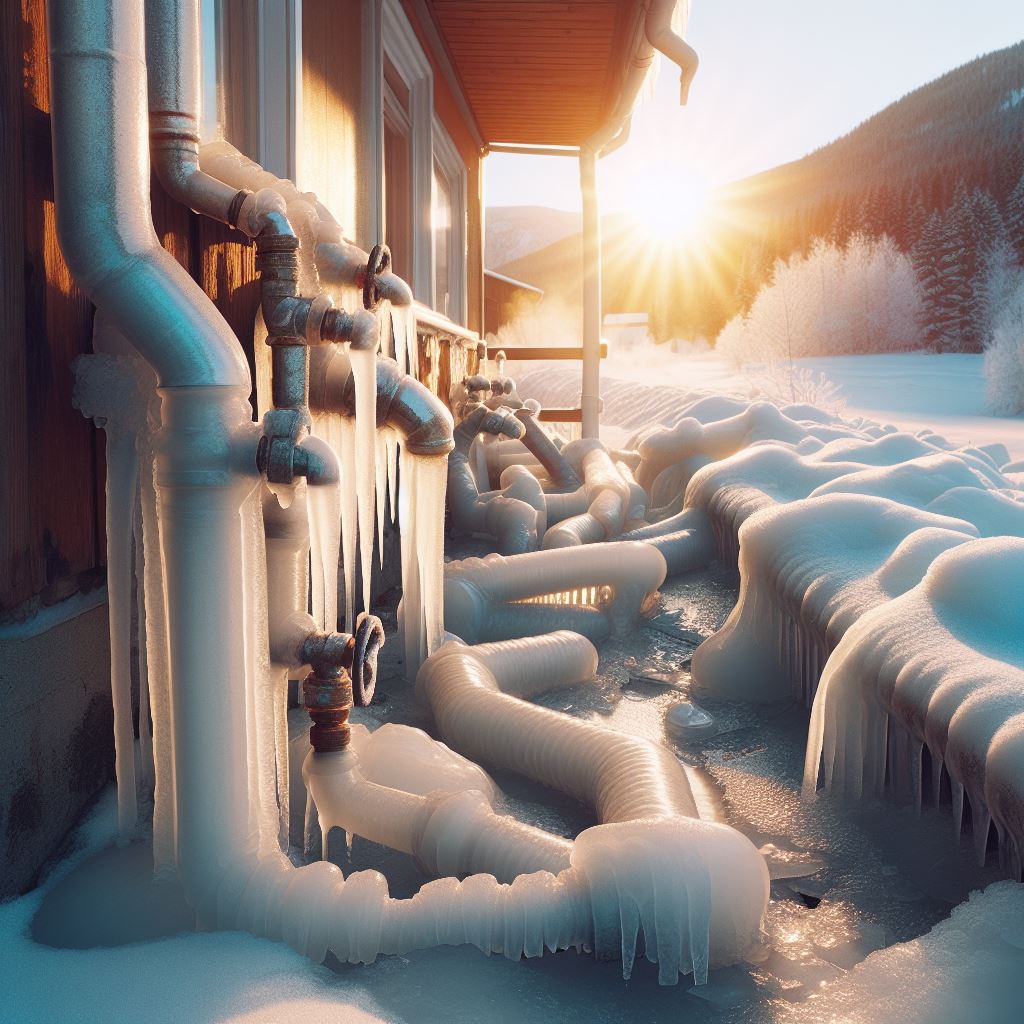Frozen water pipes can be a homeowner’s nightmare, especially during cold winter months. This situation will bring to the serious risk and consequences. When water freezes in a pipe, it exerts pressure at over 2,000 pounds per square inch, capable of rupturing any pipe. Initially, there might be no leaks as the ice blocks the pipe, but as it thaws, a major flood threat emerges. Many homeowners returning from winter vacations have faced devastating damage, with water destroying walls, ceilings, and floors, resulting in substantial financial losses.
Pipes are most susceptible to freezing when they are located:
- In an outside wall that is subject to freezing outdoor temperatures
- In a cabinet under a sink (especially when located near an outside wall)
- In an unheated basement
- Near outdoor faucets (hose bibs) used to connect garden hoses

Causes of Frozen Water Pipes:
- Low Temperatures: Sub-zero temperatures cause water inside pipes to freeze and expand.
- Inadequate Insulation: Poor insulation in vulnerable areas leaves pipes susceptible to freezing.
- Drafts and Air Leaks: Cold air drafts around pipes contribute to freezing. Identify and seal drafts to prevent this issue.
Preventive Measures for Cold Weather:
- Insulation: Properly insulate exposed pipes, especially in vulnerable areas.
- Sealing Drafts: Seal gaps in walls, floors, and ceilings to prevent cold air from reaching pipes.
- Maintain Adequate Heating: Keep your home consistently heated, even when away.
- Drip Faucets: Allow faucets connected to vulnerable pipes to drip slightly during extremely cold weather.
Thawing a Frozen Exposed Pipe: Step-by-Step Guide for a Safe and Effective Solution with AI

🚱 Identify the Frozen Area:
- Locate the section of the exposed pipe that is frozen. You may notice frost on the pipe or a lack of water flow.
🔵 Turn Off the Water Supply:
- Before starting the thawing process, it’s crucial to turn off the water supply to the affected pipe. This helps prevent any potential leaks or bursts as the ice thaws.
🌊 Open Faucets:
- Open any faucets connected to the frozen pipe. This allows water to flow and relieves pressure within the system, reducing the risk of a burst pipe.
🌡️ Apply Heat:
- Use a safe heat source to thaw the frozen section. Here are some effective methods:
- Hairdryer: Direct warm air along the length of the frozen pipe, starting from the faucet end and moving towards the blockage.
- Heat Lamp: Position a heat lamp near the frozen area, maintaining a safe distance to avoid any hazards.
- Electric Heating Pad: Wrap the heating pad around the frozen pipe and leave it on until the ice melts.
🌀. Hot Towels or Rags:
- If the frozen pipe is accessible, wrap it with towels or rags soaked in hot water. This can speed up the thawing process.
🚹 Monitor the Thawing:
- Continuously monitor the thawing progress. Never leave the heat source unattended, and avoid using open flames to thaw pipes, as this can pose a fire hazard.
🛢️ Thawing from the Inside:
- If the frozen pipe is in a location where it can’t be easily accessed or if you’re unable to thaw it from the outside, you can attempt to thaw it from the inside by turning on the faucet and allowing warm water to flow through.
🛠️ Patience is Key:
- Thawing a pipe takes time. Be patient and avoid using excessive force or sharp objects to chip away at the ice, as this can cause damage to the pipe.
🛡️ Confirm Water Flow:
- Once you observe a steady flow of water from the faucet connected to the thawed pipe, you can turn off the faucets and restore the water supply.
🦋 Insulate and Prevent Future Freezing:
- After successfully thawing the exposed pipe, take preventive measures to insulate it and minimize the risk of future freezing. Consider using pipe insulation or heat tape for added protection.
Winter’s chill poses a threat to our pipes, but armed with prevention tactics and thawing know-how, we can keep our homes warm and water flowing. Insulate, seal, and maintain heat – simple steps for a worry-free winter. In case of a freeze, swift, gentle thawing can save the day. Winter-ready homes mean peace of mind. Stay warm, stay smart, and let your pipes flow freely through the season🏡✨

